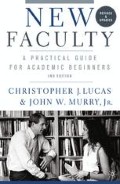Abstract
Faculty in virtually all the nation’s leading colleges and universities these days are expected to “do” research and to publish their findings. Even in institutions where teaching traditionally has been the primary mission, a faculty member’s publication record is fast becoming a dominant consideration governing annual contract renewals, promotion, tenure, and salary adjustments. Recent trends at a growing number of four-year schools now clearly favor publishing as the assured route to career success.1 The predictable result has been an outpouring of faculty-generated literature: a veritable avalanche of articles, research publications, technical reports, scholarly books, and new academic journals—the whole of almost stupefying proportions.
Access this chapter
Tax calculation will be finalised at checkout
Purchases are for personal use only
Preview
Unable to display preview. Download preview PDF.
Notes
Robert T. Blackburn and Janet H. Lawrence, Faculty at Work, Motivation, Expectation, Satisfaction (Baltimore: The Johns Hopkins University Press, 1995), 115.
Henry Rosovsky, The University, An Owner’s Manual (New York: WW.Norton and Company, 1990), 84–98.
Jaroslav Pelikan, Scholarship and Its Survival: Questions on the Idea of Graduate Education (Princeton: Carnegie Foundation for the Advancement of Teaching, 1983), 64.
Benjamin R. Barber, An Aristocracy of Everyone: The Politics of Education and the Future of America (New York: Ballantine, 1992), 196.
Robert Solomon and Jon Solomon, Up the University, Re-Creating Higher Education in America (Needham Heights, Mass.: Addison-Wesley, 1993), 12–13.
William D. Schaefer, Education Without Compromise, From Chaos to Coherence in Higher Education (San Francisco, Calif.:Jossey-Bass, 1990), 108–109.
See Peter J. Gray, Robert C. Froh, and Robert M. Diamond, A National Study of Research Universities: On the Balance Between Research and Undergraduate Teaching (Syracuse, New York: Center for Instructional Development, Syracuse University, March 1992), 6.
Consult also Carolyn J. Mooney, “Professors Feel Conflict between Roles in Teaching and Research,” Chronicle of Higher Education (May 8, 1991): A15.
See David S. Webster, “Does Research Productivity Enhance Teaching?” Educational Record 66 (Fall 1985): 60–62
and S. D. Neill, “No Significant Relationship Between Research and Teaching, Research Reveals,” University Affairs 30 (April 1989): 18.
Jacques Barzun, Begin Here: The Forgotten Conditions of Teaching and Learning (Chicago, Illinois: University of Chicago Press, 1991).
See Page Smith, Killing the Spirit, Higher Education in America (New York: Viking, 1990), 7, 20,179,197–198.
George C. Douglas, Education Without Impact: How Our Universities Fail the Young (New York: Birch Lane, 1992), 68–70, 100–101.
Christopher J. Lucas, Crisis in the Academy, Rethinking Higher Education in America (New York: St. Martin’s Press, 1996), 187.
A. Clay Schoenfeld and Robert Magnan, Mentor In A Manual, Climbing the Academic Ladder to Tenure (Madison, Wis.: Magna Publications, 1992), 218.
Joseph M. Moxley, Publish, Don’t Perish, The Scholar’s Guide to Academic Writing and Publishing (Westport, Conn.: Greenwood Press, 1992), xvii, 5, 172.
Ralph E. Matkin and T. F. Riggat, Persist and Publish, Helpful Hints for Academic Writing and Publishing (Niwot, Colorado: University Press of Colorado, 1991), 26.
Gerald W Gibson, Good Start: A Guidebook for New Faculty in Liberal Arts Colleges (Bolton, Mass.: Anker Publishing Company, 1992), 135.
Robert Boice, The New Faculty Member, Supporting and Fostering Professional Development (San Francisco, Calif.: Jossey-Bass, 1992), 18.
Boice, Advice for New Faculty Members, Nihil Nimus (Needham Heights, Mass.: Allyn & Bacon, 2000), 22.
Kenneth T. Henson, “So You Want to be Published?” Kappa Delta Pi Record 35 (Winter 1999): 79.
Henson, “Writing for Publication, Some Perennial Mistakes,” Phi Delta Kappan 78 Qune 1997): 781.
Donald W Fiske and Louis Fogg, “But the Reviewers Are Making Different Criticisms of My Paper!” American Psychologist 45 (May 1990): 591–598.
Tara Grey, “Publish, Don’t Perish: Twelve Steps to Help Scholars Flourish,” Journal of Staff, Program, and Organization Development 16 (Winter 1998–1999): 142.
Author information
Authors and Affiliations
Copyright information
© 2007 Christopher J. Lucas and John W. Murry, Jr.
About this chapter
Cite this chapter
Lucas, C.J., Murry, J.W. (2007). Getting Published. In: New Faculty. Palgrave Macmillan, New York. https://doi.org/10.1057/9780230107427_6
Download citation
DOI: https://doi.org/10.1057/9780230107427_6
Publisher Name: Palgrave Macmillan, New York
Print ISBN: 978-0-312-29537-0
Online ISBN: 978-0-230-10742-7
eBook Packages: Palgrave Social & Cultural Studies CollectionSocial Sciences (R0)

